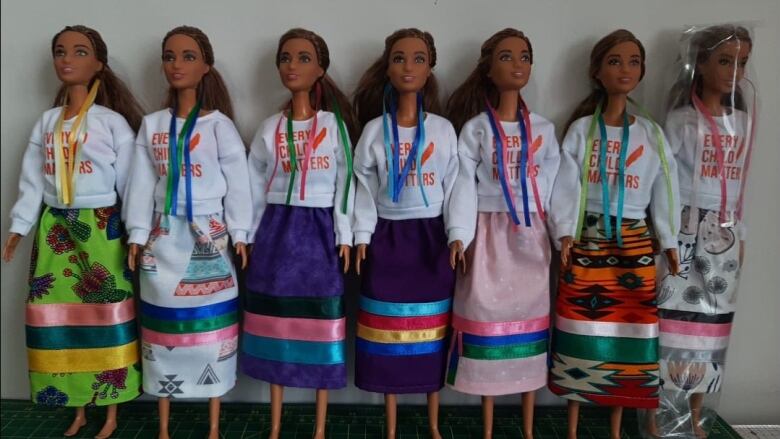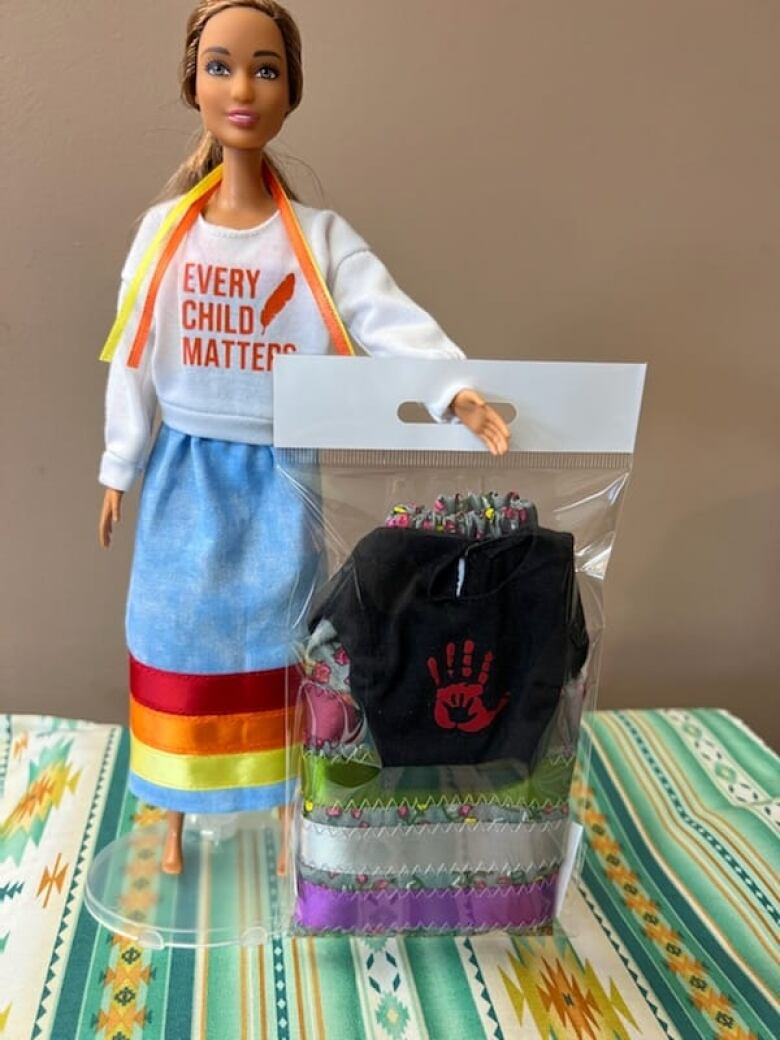Artisan hopes ribbon skirt dolls teach Indigenous girls 'their bodies are sacred, they're not to be abused'
Tracy Boucher has already sold hundreds of dolls, with 50 more people on waiting list

People around the world have reached out to Tracy Boucher, trying to get their hands on one of her handmade Indigenous dolls.
She made 40 dolls to sell at an Edmonton Christmas market, but was shocked at how many people wanted one.
"They sold in 15 minutes and over 500 people wanted the dolls," said Boucher, an Indigenous artisan from Alexander Cree Nation, about 45 kilometres northwest of Edmonton.
Boucher, a member of the Indigenous Artist Market (I.A.M.) Collective and owner of TB Crafting, started making dolls dressed in handmade ribbon skirts an important piece of clothing in some Indigenous cultures last November.
Ribbon skirts must be long enough that they can connect with the grass a symbol of Mother Earth's hair, she said. When a person wearing a ribbon skirt walks along the earth, it touches the hairs of Mother Earth, letting her know "we are women and we are there."
The ribbon skirt teaches Indigenous girls and two-spirited kids that "they are very precious and sacred," Boucher said, and she hopes her dolls can help impart that message.
High demand for dolls that look like Indigenous girls
Boucher first got the idea to make the dolls after realizing there was nothing for kids to buy at the store outside the Indigenous Peoples Experience Pavilion at Fort Edmonton Park.
Her daughters, growing up, played with blonde-haired, blue-eyed Barbies, so she knows how parents feel about getting their kids a toy that looks like them.
"It means the world that our kids can proudly display their dolls, wear their ribbon skirts, identify with who they are and how they look," she said.
Boucher designed the dolls with girls in mind, but two-spirited kids are also drawn to them. Two-spirited people are traditionally thought to walk both the male and female paths of life, and Boucher uses rainbow skirts to make their dolls stand out.
She makes batches of about 40 skirts at a time; each batch takes about a week to make.

Boucher initally planned to sell the dolls at a Christmas market. But one of her daughter's took a picture of the dolls and posted it on social media beforehand.
They were flooded with replies.
Since then, about 600 people have bought one of Boucher's dolls, and she said there are 50 more people on the waiting list.
But Covid-related supply issues have made it more difficult to find dolls to dress in handmade clothing. For people who don't want to wait, Boucher is selling clothing for people to use on their own dolls.
Some of those looking to purchase dolls are family members of women who have come to symbolize the MMIWG movement. Boucher said the family of Chantel Mooreasked for a doll for Moore's daughter.
[Indigenous girls] need to know that their bodies are sacred, they're not to be abused.- Tracy Boucher
In 2020, Chantel Moore was fatally shot by police in New Brunswick during a wellness check at her apartment. The officer involved did not face charges following an investigation by Quebec's police watchdog, and an inquiry into her death has been further delayed until May 16.
Boucher says she's glad to know Moore's daughter and other girlsnow have dolls that validate their identity.
"It just makes my heart soar," she said.
Teaching Indigenous girls their worth
The main goal, Boucher said, is to bring attention to missing and murdered Indigenous women and girls (MMIWG) and children sent to residential schools. She dresses her dolls in sweaters emblazoned with "MMIWG" or "ECM" (Every Child Matters).
Boucher'sown father was a survivor of St. Albert Youville residential school, so she knows of the horrors children experienced at those institutions.
"When they started discovering all of the unmarked graves [at other former school sites], society was like, 'oh my God, this didn't happen.' But all Indigenous people knew it was there," Boucher said.
The final report National Inquiry into MMIWG stated that past abuses against Indigenous people, and the resulting intergenerational trauma, are the root cause of violence against Indigenous women, girls and 2SLGBTQ people.
A Statistics Canada survey suggests three in five Indigenous women have experienced some form of intimate partner violence.
Boucher's dolls allow her to take a stand against that violence.
"[Indigenous girls] need to know that their bodies are sacred, they're not to be abused," she said.
"They need tohave self-respect, self-confidence and to know that they mean something in the world."












_(720p).jpg)


 OFFICIAL HD MUSIC VIDEO.jpg)
.jpg)



























































































